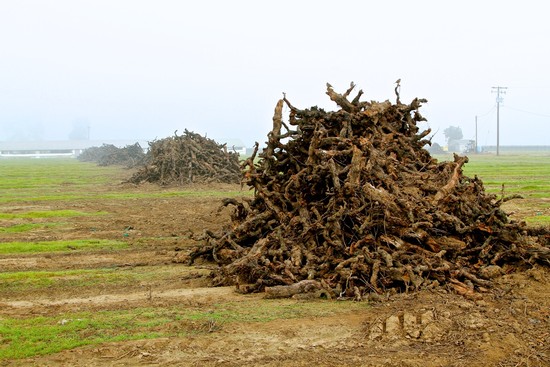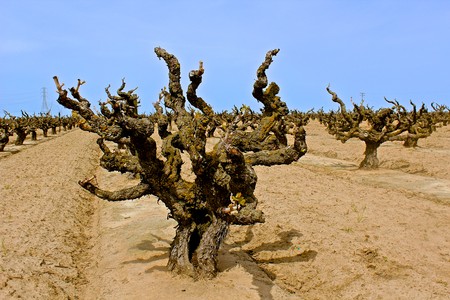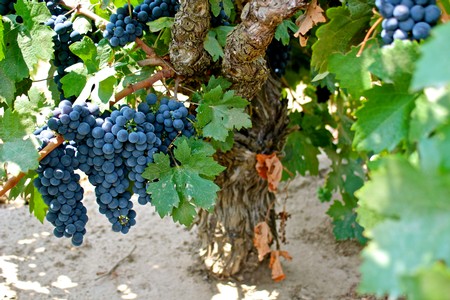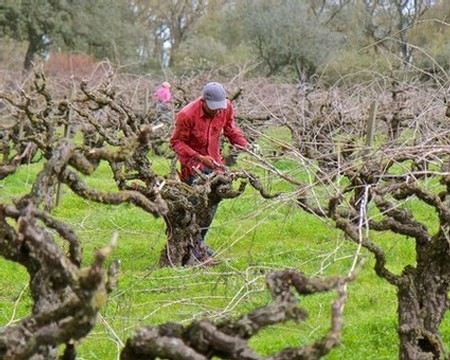Letters from Lodi
An insightful and objective look at viticulture and winemaking from the Lodi
Appellation and the growers and vintners behind these crafts. Told from the
perspective of multi-award winning wine journalist, Randy Caparoso.
Last Rites for Lodi's old vine growths

Typical fall scene in Lodi wine country: another old vine vineyard bites the dust
The Phillips Family Issues Dire Warnings
Imagine a Lodi without old vine Zinfandel. It’s not an impossibility.
This issue always comes up in years when yields are down, as they were in 2017, 15%, 25%, or even more than 50%. This time around it comes in the middle of an economic clusterfudge: Sales of $10-and-under varietal Zinfandel continue to drop, winery supplies of fermented juice are backed up to the hilt, and White Zinfandel is no longer setting the wine world on fire (hasn’t for a while).
So right now, the question for many Lodi growers still sitting on old, gnarly, head rained, spur pruned Zinfandel planted prior to 1967 – the Historic Vineyard Society defines “old vines” as anything over 50 years old – is, why bother?
Why not pull out the old vines that aren’t turning a sufficient profit, replant with higher yielding varieties selling for far more or at least are in much bigger demand (currently, for instance, grapes like Cabernet Sauvignon, Petite Sirah and even Sauvignon blanc fit the bill better), and be done with it? To heck with old vine Zinfandel.

Classic Lodi growth: 116-year old, own-rooted Marian's Vineyard Zinfandel
This worries Kevin Phillips no end. Mr. Phillips is the Vice President of Operations for Lodi’s wildly successful Michael David Winery and its agricultural arm, Phillips Farms. Nearly half of Michael David’s current 1-million-case yearly production is its ubiquitous 7 Deadly Zins, which sells for $16 to $20 across the country, plus in more than a dozen foreign countries.
Last week, half-way through the frantic (aren’t they all?) 2017 harvest, Mr. Phillips took the time to send out an FYI, saying: “I think a lot of old vine zins will be getting yanked out of the ground this year, mostly due to labor shortages. Lodi will obviously be ground zero for this phenomenon. This is living history being demolished; the very story that actually helps Lodi attract media attention.”
The Phillips family, led by co-owners Michael (CEO) and David (President) Phillips, has never made any bones about why their signature 7 Deadly Zins has enjoyed such explosive success over the past 15 years: Because it consists primarily of old (not young) vine Zinfandel. So the last thing they want to see is a Lodi bereft of old vines.

One of the original "7 Deadly Zins" vineyards: the 101-year-old Soucie Vineyard
7 Deadly Zins is living proof that the quality of wines sourced directly from vines of a certain age can make a difference. In our own blind tastings we have found that 7 Deadly Zins can out-Zin Zinfandels twice its price, while epitomizing the soft, lush, spicy yet somewhat earthy, fine and delicate qualities of Lodi grown fruit (it’s an urban myth that Lodi only produces “big, ripe wines”). How do they do that? Because 7 Deadly Zins doesn’t cut corners insofar as quality grape sources, and Lodi terroir rules – at least insofar as Zinfandel.
Adds Kevin Phillips, in sounding the alarm to others in the Lodi winegrowing community: “Now is the time to create a protocol and lead. If we don't, we may have an epidemic on our hands. Our living history of Lodi viticulture is at risk, and it's up to us to combat that. It would be great to start compiling pictures and histories of these vineyards as well as documenting their removal. Print it, email it, blog it – getting the word out is the first step.”

Peirano's Lance Randolph (post-harvest, sans red shorts) among his +100-year-old vines
Resigned to the Inevitable
For all of Phillips’ dire warnings, a good number of old vine plantings in Lodi are scheduled to be pulled out as soon as the last grape is picked, which in Lodi is when Peirano Estate’s Lance Randolph pulls off his red shorts. Ask some of the Lodi vineyard managers about this, and the response is, well, c’est la vie. For instance, Aaron Shinn, Vineyard Manager for Lodi’s Round Valley Ranches, tells us, “This is a shared concern of mine.... but the removal of these heritage blocks is the unfortunate collateral damage of the current business climate in California. The bottom line is, as a grower, you have to be paid an ever-increasing premium to justify the rising expense and low yield of old head trained vines.”
Vino Farms LLC Vice President Craig Ledbetter agrees; telling us: “This is a revenue issue. You cannot continue to farm these old blocks of Zinfandel that do not produce at a level that keeps price sustainable. Today the Zinfandel market is struggling, and growers cannot afford to farm at 3-5 tons/acre because the total revenue per acre is not a return that keeps growers in business. At the end of the day, we growers farm to make a living, not break even or even lose money.”

Zinfandel harvest in McCay's TruLux Vineyard (planted in 1940s on St. George rootstock)
Shinn cites the labor issues: “There is an increase in the cost required to maintain old vines. Wages are increasing so rapidly (including a $15/hour minimum wage hike and changes in overtime regulations) that grape prices from large wineries can't keep up. Large wineries would rather see these old blocks pushed aside and replaced with mechanically adaptable plantings; rather than pay more for the fruit coming from old vines. “
The long, productive, close working relationship between Lodi growers and giant sized, value wine producers may, in fact, may be the region’s undoing. Tegan Passalacqua – the Winemaker/Manager of Turley Wine Cellars as well as owner of his own Kirschenmann Vineyard on Lodi’s east side – minces no words in saying: “The loss of old vine vineyards is not just a labor issue. I don’t want to name names, but this is really on the big wineries who are offering just $550/ton, whereas just a few years ago they were offering $900/ton plus bonuses for hand picked, old vine Zinfandel.
“This year I’ve heard that some growers were dropped by the big guys because they wouldn’t take their low-ball offerings. I know Kevin Phillips picked up some of those vineyards after contracts were dropped. Michael David pays considerably more, but they can’t ‘save’ all of them. So I can understand Kevin’s frustration.”

Turley's Tegan Passalacqua in his Kirschenmann Vineyard (own-rooted east side Lodi Zinfandel planted in 1915)
Passalacqua, as it were, is also one of the founders of the Heritage Vineyard Society, dedicated to the task of chronicling as many old vine plantings in California as possible, with the express purpose of preservation. Adds Passalacqua: “For Lodi, things like old vine Zinfandel is more than an economic product. Old vines in Lodi also have cultural value. Lodi doesn’t hang its hat on ‘young vine Cabernet,’ and why should it?”
There are those, of course, who say that site, or Lodi terroir, is a bigger factor than vine age when it comes to actual quality; in which case, more productive, machine-harvested young vines are just as good as old vines, which always require high-cost hand picking. Passalacqua vehemently disagrees, speaking from the perspective of a winery specializing in Zinfandels – arguably California’s most prestigious – sourced from both old and young vines up and down the state. Says Passalacqua, “I’ll argue until I’m blue in the face that, 99 times out of 100, old vines will always produce a better wine, and we can show you the chemistry to prove it.”

This dry-farmed, own-rooted +100-year-old Zinfandel plant in Noma Ranch was pulled out in 2015
Replacing the Irreplaceable
(and Not-So-Simple Solutions)
Speaking from the perspective of a winery owner/winemaker (St. Amant Winery) as well as Lodi Winegrape Commission Program Director, Stuart Spencer tells us: “To my knowledge, nowhere else in the wine world do you find as much old, own-rooted, head trained vines as you do in Lodi. These Zinfandel vines are iconic – part of our identity and who we are in Lodi – yet have become truly difficult to sustain. The economic threat is real. But this can also be an incredible opportunity in Lodi for winemakers to work even more with undiscovered old vine vineyards. Vineyards that have a story, a family history, and are waiting for the right winemakers to come along and tell it.”
Mike McCay – who produces a good half-dozen single-vineyard bottlings of Zinfandel (as well as Carignan) under his McCay Cellars label – is one of those winemakers in constant search of ancient vine growths, which he calls “buried treasure.” Says McCay: “What makes old vines special is their inherent character. There’s a reason why there is more of this in Lodi than in any other region. The sandy soil (particularly the Tokay series of Lodi's Mokelumne River AVA) and Mediterranean climate is perfectly suited to these old vines, and roots go down 30, 40 feet – you just can’t replace that.”

Zinfandel clusters on 101-year-old, own-rooted vine in Soucie Vineyard, on Lodi's far west side
The issue, says Passalacqua, is also a “grape/bottle price ratio” that simply doesn’t work for old vine plantings going into wines selling for less than $10/bottle. “The thing is,” says Passalcqua, “$550/ton is maybe a break-even point for Lodi growers. When yields are less than 5 tons, like many were this year, it’s a loss. The problem is that big wineries that have had a lock on many of Lodi’s old vines just don’t value them the way we do in, say, Napa Valley. Many of the winemakers and vineyard managers who work for the big wineries may care deeply about old vines and growers in Lodi, but not their CFOs. Ironically, of course, if Lodi loses most of these old vineyards, what’s left of them will finally become valuable.
“In Napa, for instance, you can no longer find Zinfandel, old or young, for even $5,000/ton. It’s impossible, as much as wineries like Robert Biale and Turley are willing to pay for them. If that happens to Lodi, I guarantee a lot of growers who tore out their old vines will kick themselves in the pants later. Maybe Lodi as a community needs to work harder on finding wineries outside the region who can appreciate the old vines a little more – before it’s too late.”

Winter pruning of Lodi's oldest Zinfandel growth: Jessie's Grove's Royal Tee Vineyard (planted 1889)
Mr. Shinn concurs; adding, “We should do whatever it takes to attract more mid-level wineries to the area – producers who see the value in this special fruit and are willing to pay extra for it. I’d stand behind any formal effort put forth by the Lodi Winegrape Commission or Lodi District Grape Growers Association to create awareness of these heritage blocks that are so vital to the history of Lodi. But at the end of the day, economics trump all, and there may be only so many Michael Davids out there, willing to pay the necessary premium.”
The solution is “simple,” says Mike McCay; but at the same time, it's not. According to McCay: “We always pay top dollar for old vines, but it’s taken years to convince some of these old time growers to even sell to us. In many of these cases, the growers simply would rather sell to one big producer than deal with a bunch of small producers. In other cases, it’s big wineries dictating to growers – they simply don’t want to share their vineyards. We want to do our part to keep historic vineyards in the ground, but not everone has the same priority.”
Whatever the case, it may take more than a publicity campaign to stop the bleeding. It will take a sea change, in approach and culture; or as Passalacqua often puts it, “from grape growing to winegrowing.” Spencer summarizes everyone’s concerns by saying, “The only way these vineyards survive is by connecting them to winemakers, and by extension consumers, who value the vineyards for the wines they make, not the tons they produce.
“These vineyards produce incredible, mind-blowing wines that speak truly of Lodi – our ‘living history,’ as Kevin (Phillips) calls it, or like beautiful pieces of art. We should all feel – growers and wineries alike – a strong sense of responsibility and duty to help tell their story, and keep them alive for future generations.”
Please see our continuation post, What Lodi can do to slow down the loss of old vine plantings

Zinfandel picked in Turley's Dogtown Vineyard (Clements Hills growth, planted 1944)